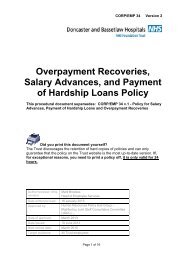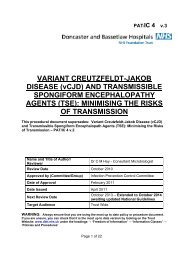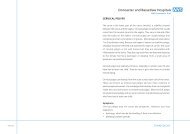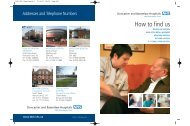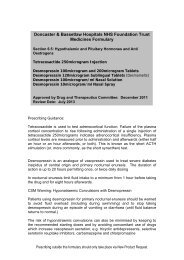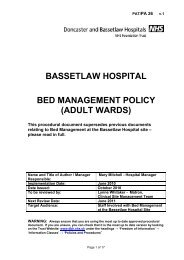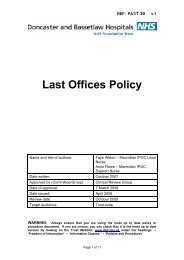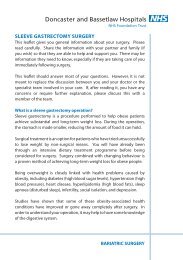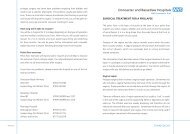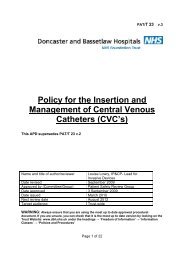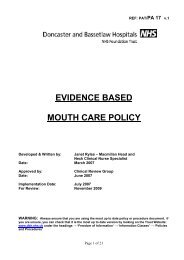acute neck sprain and whiplash injuries - Doncaster and Bassetlaw ...
acute neck sprain and whiplash injuries - Doncaster and Bassetlaw ...
acute neck sprain and whiplash injuries - Doncaster and Bassetlaw ...
You also want an ePaper? Increase the reach of your titles
YUMPU automatically turns print PDFs into web optimized ePapers that Google loves.
ACUTE NECK SPRAIN AND WHIPLASH INJURIES<br />
What is a <strong>whiplash</strong> <strong>neck</strong> <strong>sprain</strong>?<br />
A <strong>whiplash</strong> <strong>neck</strong> <strong>sprain</strong> occurs when your head is suddenly forced<br />
backwards <strong>and</strong> forwards on the body. This type of injury is common in<br />
car accident collisions, but most of these <strong>injuries</strong> are not serious <strong>and</strong><br />
permanent damage is rare.<br />
It is the <strong>neck</strong> muscles, ligaments, <strong>and</strong> small joints that can be affected<br />
by being stretched more than normal. The body has a natural ability<br />
to repair itself however it can be common to suffer from the following<br />
symptoms:<br />
• <strong>neck</strong> pain <strong>and</strong> stiffness<br />
• dizziness<br />
• head aches<br />
• pins <strong>and</strong> needles/numbness<br />
• back pain<br />
• jaw pain<br />
• shoulder <strong>and</strong> arm pain.<br />
What is the outlook after a <strong>whiplash</strong> <strong>neck</strong> <strong>sprain</strong>?<br />
The outlook in most cases is good, but the time taken for symptoms to<br />
settle varies from person to person. In most cases, symptoms are much<br />
better or gone within one to four weeks. Sometimes aches <strong>and</strong> pains can<br />
persist or recur for quite a long time after a <strong>whiplash</strong> injury. Experiencing<br />
good <strong>and</strong> bad days is a normal part of getting better.<br />
What will help your symptoms?<br />
Painkillers<br />
It is helpful to take painkillers regularly such as Paracetamol or antiinflammatories,<br />
until the pain eases. This will help you move your <strong>neck</strong><br />
<strong>and</strong> stay active. It may be necessary to seek advice from your GP or<br />
pharmacist if you have difficulty controlling the pain.<br />
PHYSIOTHERAPY
Heat <strong>and</strong> cold<br />
The use of hot <strong>and</strong> cold applied locally to the <strong>neck</strong> can provide some<br />
short term pain relief <strong>and</strong> help relax muscle spasm.<br />
Cold application is most effective for the first few days after injury. Wrap<br />
a bag of frozen peas in a damp teatowel <strong>and</strong> apply across the back of<br />
your <strong>neck</strong> <strong>and</strong> shoulders for about 5-10 minutes <strong>and</strong> repeat 3-4 times<br />
during the day.<br />
Heat is usually most effective after the first three days. Using a hot water<br />
bottle wrapped in a towel, or a wheat bag, apply for 15-20 minutes <strong>and</strong><br />
repeat as necessary throughout the day.<br />
Posture<br />
Poor posture can delay your recovery <strong>and</strong> it is important to avoid<br />
slouching <strong>and</strong> sitting with your chin poking forward. Try to sit up straight<br />
with a hollow in your lower back. Use a rolled-up towel placed at the level<br />
of your waistb<strong>and</strong> to help to maintain this position. Keep your shoulders<br />
pulled back <strong>and</strong> relaxed.<br />
PHYSIOTHERAPY<br />
Avoiding staying in one position for<br />
long periods, eg sitting or driving.<br />
Change your position regularly to help<br />
you avoid adopting poor postures <strong>and</strong><br />
avoid prolonged periods of inactivity.<br />
Sleeping<br />
Try to sleep with your head in line<br />
with the rest of your body; avoid over-<br />
bending or twisting at the <strong>neck</strong>. You<br />
may need to adjust the number of<br />
pillows that you use to allow this. One<br />
is usually adequate when lying on your back, but two may be better if<br />
you sleep on your side.<br />
A small rolled-up towel placed in the crook of your <strong>neck</strong> will help to fill<br />
the gap between your <strong>neck</strong> <strong>and</strong> shoulders <strong>and</strong> support your <strong>neck</strong>. You<br />
may also find it helpful in the initial days following your injury that, while<br />
changing position in bed, you use your h<strong>and</strong>s to support the weight of<br />
your head.
Upon waking, gentle movements of the <strong>neck</strong> will help to relieve any<br />
stiffness that may occur following sleeping.<br />
Activity <strong>and</strong> rest<br />
It is important to start moving your <strong>neck</strong> as early as possible as this will<br />
help the healing process. The long-term outlook is good if you can get<br />
your <strong>neck</strong> moving early.<br />
Immediately after injury, you may require a short period of rest.<br />
However, resting after the first three days can seriously delay recovery<br />
<strong>and</strong> may lead to long-term pain. Develop a balance between periods of<br />
rest <strong>and</strong> regular gentle exercise to prevent stiffness.<br />
You may need to change what you do if certain activities aggravate your<br />
pain. Do not avoid activities through fear of feeling pain - modify them!<br />
People who try to continue with their daily activities, <strong>and</strong> do regular<br />
gentle exercises despite the pain, cope better with a <strong>whiplash</strong> injury.<br />
Exercise<br />
It is important to get the movement back in your <strong>neck</strong> as soon as<br />
possible. Gentle regular exercise will help keep your <strong>neck</strong> mobile <strong>and</strong><br />
help reduce the pain.<br />
Gentle movements of the <strong>neck</strong> as shown - bending your head forwards,<br />
bending your head upwards, side-to-side movements, <strong>and</strong> rotating your<br />
look over each shoulder - should be done regularly throughout the day.<br />
Ten repetitions of each exercise four to five times daily, will help improve<br />
<strong>neck</strong> movement <strong>and</strong> reduce pain.<br />
PHYSIOTHERAPY
WPR32700<br />
June 2010<br />
PHYSIOTHERAPY<br />
Within the first three days exercises<br />
should be performed within a<br />
comfortable range. After this, you<br />
should try to increase the movement<br />
through a larger range.<br />
Exercising an area of the body that is<br />
injured can cause discomfort but it does<br />
not mean that you are causing harm.<br />
However, if an exercise aggravates<br />
your symptoms considerably, or makes<br />
you feel dizzy, stop <strong>and</strong> seek advice from your doctor or physiotherapist.<br />
Contact details:<br />
Physiotherapy Departments<br />
<strong>Doncaster</strong> Royal Infirmary 01302 366666 ext: 3135/3585<br />
<strong>Bassetlaw</strong> Hospital 01909 500990 ext: 2320<br />
Montagu Hospital, Mexborough 01709 585171 ext: 5626<br />
Retford Hospital 01777 863400



